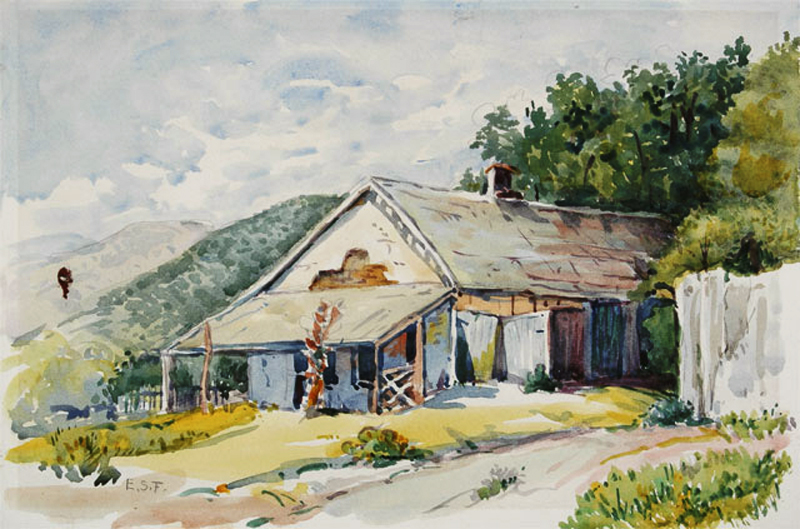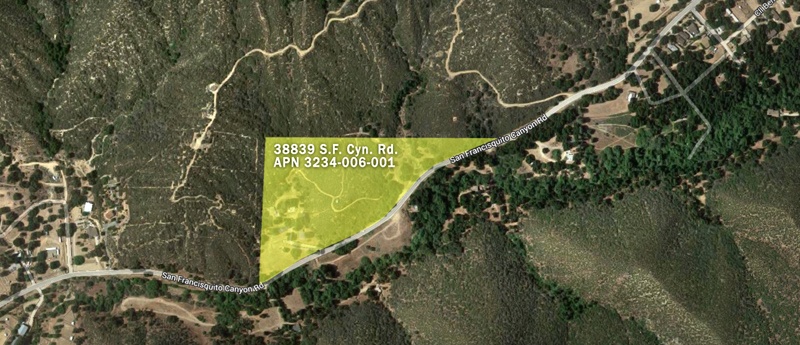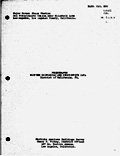|
|

Watercolor, March 1915, by Eva Scott Fenyes, titled "The Old Butterfield Stage Station in San Francisquito Canyon. Shows Major Gordon's Stage Station. Photo in the Autry National Center, courtesy of the Southwest Museum of the American Indian Collection. See biography of artist below. Major Gordon's Station was erected circa 1859 by Aneas Gordon along the Butterfield Overland stagecoach route on San Francisquito Road (aka San Francisquito Canyon Road), four miles southwest of Elizabeth Lake and 20 miles north of the future town of Saugus. Update: It was located at what is now 38839 San Francisquito Canyon Road, just southwest of Green Valley. It was razed in the 1960s. See map below. According to historian Bonnie Ketterl Kane of the Ridge Route Communities Historical Society, Aneas Gordon had previously operated Gordon's Ferry on the Kern River, near present-day Bakersfield. An overhead cable was used to move a ferry, large enough to carry a coach and six or more horses, across the river.[1] The next stop along the route south out of San Francisco was Fort Tejon (est. 1854). Gordon sold the ferry in 1859 to Joseph Gale and apparently came to the Elizabeth Lake area at that time. According to Kane: "In 'Saga of El Tejon,' Lopez said that 'old' Major Gordon did not stay long at Gordon Station after the stages began running. He sold to Luke Smith and moved to Santa Paula where he died about 1875. Luke Smith then dies and the stop becomes known as 'Widow Smith's.' She sells to Tom Delano, who again calls the stop 'Gordon's Station.'"[2] It should be noted that Harris Newmark said he stopped at Gordon's Station in 1856. It's possible Newmark had the year mixed up, inasmuch as he wrote his reminiscences from memory, 60 years later. On the other hand, it's possible the names "Major Gordon's" and "Widow Smith's" were interchangeable. Historian Kirby Sanders, a career journalist and author of "Driver's Guide to the Butterfield Overland Mail Route" (2008), offers the following: While it appears that "Major Gordon's Station" and the Butterfield "Widow Smith's Station" are likely at or near the same place, there also appears to be some confusion in the naming of the place over different dates. Goddard Bailey, a United States Post Office postal inspector based in San Francisco, made the first trip of the Butterfield Overland Mail from San Francisco to Saint Louis, Mo., commencing Sept. 15, 1858. He was charged with supplying an official report to Postmaster General Aaron V. Brown with an official on the stations and the distances between them. The report was filed in October 1858. In the report, Bailey clearly identifies this station as being "Widow Smith's" and identifies its location as being 24 miles from "French John's" and a further 10 miles onward to "King's"[a][b]. Waterman Ormsby, in his 1858 description of the east-to-west journey of the first Butterfield run, does not specifically mention this station[c]. Roscoe and Margaret Conkling, in their Butterfield study published in 1947, also indicate that "the names of two others, John F. Gordon, and a Mr. Wilburn" were also associated with this station[d]. What appears to be at issue is the date and order of transfer between Anaeas Gordon and Luke Smith. The matter of reference by Harris Newmark to a stop at Gordon's Station in 1856 could also relate to a stop at Widow Smith's, using a more familiar vernacular ("Major Gordon") at the time he wrote his memoir. None of the above is intended as a criticism of others' contributions and research. Rather, it is merely to point out an historical anomaly in the record — an anomaly we would all be well served to sort out.
— Kirby Sanders REFERENCES: a. Bailey, Goddard. "California — Arrival of the Overland Mail — Itinerary of the Route," as reported in the New York Times, Oct. 14, 1858. b. Bailey, Goddard. Report to Postmaster General A.V. Brown. Full itinerary as reported by De Bow's Review and Industrial Resources, Statistics etc.; published by De Bow's Review, New Orleans and Washington City, 1858. See specifically "Internal Improvements - 1. Wagon Road to the Pacific," pp 719-721. c. Ormsby, Waterman L. "The Butterfield Overland Mail (Only Through Passenger on the First Westbound Stage)," original publications, New York Herald, Sept. 26 to Nov. 19, 1858; republished by Henry E. Huntington Library and Art Gallery, San Marino, Calif., 1942-1998. d. Conkling, Roscoe P. and Margaret B. "The Butterfield Overland Mail, 1857–1869" (3 vols), Glendale, Calif.: A.H. Clark Co., 1947. As an aside, Kirby, who lives in Houston, is pursuing a federal designation for the original Butterfield Overland route as a historic trail, in recognition of its importance as America's first real "information superhighway," running from the Mississippi River to the Pacific Coast. Further Reading: Gordon's Station and Ferry by José Jesús López, circa 1930. The remains of Major Gordon's Station were photographed and surveyed in 1936 and 1937 by Henry F. Withey, Los Angeles District Officer for the Historic American Buildings Survey (HABS). At the time, the property was owned by Herbert G. Boyd of 601 N. Jackson St. in Glendale, Calif. HABS surveys were performed at historic sites across the country under the auspices of the Works Progress Administration, one of several agencies established under FDR's New Deal to create government-sector jobs during the Depression. In his survey, Withey — an architect of some renown in Los Angeles during the 1920s — incorrectly identifies Major Gordon's as "Major Gorman's Stage Station." According to Kane[3], Major Gordon's was unrelated to Gorman Station (in Gorman) or to the man for whom the community of Gorman was named. Photographs from 1936 at the Autry National Center, sourced to the Southwest Museum (and presumably emanating from Withey), corroborate the name of the station as "Major Gordon's." According to Withey's report (HABS CAL-330), the station had a "foundation of field stone laid in adobe mud (and) walls of sun dried adobe brick plastered with adobe and whitewashed; part of front plastered with lime plaster, wood floors laid directly on the soil, ceiling and roof frame of wood, roof covered with shakes." It was re-roofed in 1933. A rendering of the floor plan accompanying Withey's report, drawn by architect Clifford T. McElroy — a designer of movie theaters in Minnesota during the 1910s — elaborates on the station's construction as follows: "Foundations are of field stone laid in adobe mortar. Walls are adobe with some field stone mixed in. Walls plastered inside and out with a plastic adobe mixed with sand. Front or south gable wall over porch, lime plastered. All other outside walls heavily whitewashed. "Walls of rooms No. 1-3-4 whitewashed, walls of Room 2 papered. Ceilings and roof projections whitewashed. Doors sash and trim painted slate gray. Floors, including porch, are 1"x6" matched pine flooring laid on 2"x4"s flat on ground. "Roof framing has not the appearance of being original material. Roofing is of redwood shakes recovered in 1933. Soil has washed down from the north, raising grade at rear of building. Rear wall leans outward, by reason of settlement, about 1'-0" at peek [sic] of gable. This occurred before the roof was reconstructed. Adobe chimney has been protected with sheet metal scraps. Adobe brick are 4"x8"x16", 1/4" joints. An occasional header course but no attention paid to vertical joints." At the time of the HABS survey, the structure was "unoccupied and neglected, being used for storage of grain and farm products," Withey writes. He notes that a photograph and reference to the station were included in an article titled "In Pursuit of Vanished Days" by Marion Parks, published in 1929 by the Historical Society of Southern California. [1] Kane, Bonnie Ketterl, "A View from the Ridge Route Vol. II: The Fort Tejon Area," Bonnie's Books, Frazier Park, Calif., 2002, Pg. 139. [2] Communication from Bonnie Ketterl Kane, Nov. 12, 2012. [3] ibid. About Eva Scott Fenyes From the Autry National Center: Eva Scott Fenyes was born on November 9, 1849, the daughter of wealthy New York publisher Leonard Scott and his wife, Rebecca Briggs Scott. Eva was educated at Pelham Priory in Pelham Manor, New York, and then studied art in New York, Europe, and Egypt. In 1877 she also spent time in Fort Marion, Florida, where she asked Henry Pratt to have the artists Howling Wolf (Cheyenne) and Zo Tom (Kiowa) create ledger books for her. This early affiliation with Native American artists and her support for their work continued throughout her life. In 1878 Eva married Lt. William S. Muse (who went on to become a brigadier general). Their only daughter, Leonora, was born in 1879. After spending several years as an army wife, Eva began to spend time traveling, painting, and living in Santa Fe. In 1891 she divorced Muse and traveled extensively in Europe, Egypt, and other Middle Eastern countries. During these travels she met Dr. Adelbert Fenyes, who was a Hungarian nobleman, a doctor of nervous diseases, and an entomologist. They were married in Budapest in 1896 and settled soon thereafter in Pasadena, where Mrs. Fenyes continued to paint. FEN.1 Entry Facade of the Mission of San Diego de Alcala, San Diego, April 17, 1907 || This mission was the first one founded in Alta California by Padre Junipero Serra. The founding ceremony was performed on July 16, 1769, at a site called Kosa’aay (Cosoy) by the Indians and later known as Presidio Hill. Here the first temporary chapel was built and the first cross raised overlooking the bay and the river. The mission encountered numerous difficulties, including an attack in 1776 by 800 armed Natives, in which supplies were looted and buildings set afire. Eight months later, a much larger mission was rebuilt. A dam to provide water for the mission was completed in 1816. In 1834, when the mission was secularized, the buildings were sold and fell into disrepair. In 1862, the buildings were returned to the Church, but by 1931, when restoration began, only the facade was still standing. Although Mrs. Fenyes painted constantly, she did not exhibit her work or consider herself a "professional artist." She painted a variety of subjects and was also interested in music, archaeology, philanthropy, and history. She was an active member in many organizations, including the Pasadena Music and Art Association, Landmarks Club of California, and the Southwest Society, later serving on the board of trustees of the Southwest Museum. Her daughter, Leonora Curtin, and her granddaughter, Leonora Curtin Paloheimo, continued to serve on the board through the late 1980s. Mrs. Fenyes was instrumental in the creation of art/literary salons that brought together a wide variety of local artists, writers, and other intellectuals who met in her home in Pasadena. Among the participants in these salons were such well-known California painters as William Keith and Benjamin Brown, who described her as "too accomplished in many phases of art to become proficient in one." In my efforts to determine when Mrs. Fenyes met Charles F. Lummis, I found a letter that Adolph Bandelier wrote in response to an inquiry by Mrs. Fenyes and which probably dates between 1896 and 1898: "You ask me about Lummis. I know him INTIMATELY—perhaps better than anybody else knows him. He came with me to South America, and returned when Mr. Villard had to give me up. Lummis is a very good man and very talented as you easily glean from his writings. He has noble inspirations and fine instincts; only, bent upon the sensational and the striking, this inclination sometimes runs away with him and causes him to lose sight of the nearer duties. Honest as the day is long, sincere and impulsive; he is brave and true friend, only overanxious often to catch the startling and the glistening, almost at any cost. But he is getting calmer, and I have great hopes to see him yet in a very prominent literary position, for his is the metal [sic] for doing good and even great things. In personal appearance he is not select, but then his manners are decent and he would never knowingly do an improper, still less a wrong, thing. —I am sure you would, make [sic] allowances for his oddities, enjoy meeting him." (Fenyes File from the Bandelier Collection at the Museum of New Mexico History Library, Santa Fe, NM). In addition, Lummis has a note in his 1899 diary about the Fenyeses attending a dinner at his home. In a letter from 1904 Mrs. Fenyes asked Lummis his opinion about documenting the historic adobes, which she had started in 1898. Lummis’s response to her question on February 10 (found in a letter in the Fenyes Archives Pasadena Museum of History) was, "It seems to me it would be a very valuable thing if you could carry out your plan to make accurate watercolor studies of the old buildings in this region. Accuracy is the first requirement; and such a series would have serious historical value. I hope you may be able to realize this plan—and I am inclined to think that if you can undertake it in just the right way, you will find it better for your health than all the doctors ..." They continued their lifelong contact. In Mrs. Fenyes’s correspondence with Lummis, she often asked him for recommendations for books and/or places to stay when she was going to a place she knew he had been but with which she was unfamiliar. Although Mrs. Fenyes made a promised gift of her paintings to the Southwest Museum in 1905, her lawyer advised her to wait until the museum was incorporated, which she did.
lw2283c: 9600 dpi jpeg from jpeg in Autry National Center archive | Online image only |
The site owner makes no assertions as to ownership of any original copyrights to digitized images. However, these images are intended for Personal or Research use only. Any other kind of use, including but not limited to commercial or scholarly publication in any medium or format, public exhibition, or use online or in a web site, may be subject to additional restrictions including but not limited to the copyrights held by parties other than the site owner. USERS ARE SOLELY RESPONSIBLE for determining the existence of such rights and for obtaining any permissions and/or paying associated fees necessary for the proposed use.










